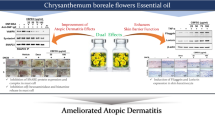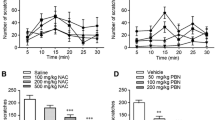Abstract
N-Stearoyl-phytosphingosine (SPS) and 4-hydroxysphinganine (phytosphingosine, PS), which are sphingolipids frequently found in mammalian skin, plants, and yeast, have been used as ingredients in cosmetics. In mice, treatment with SPS and PS inhibited histamine-induced scratching behavior and vascular permeability. These agents inhibited the expression of the allergic cytokines, IL-4 and TNF-α, and the activation of the transcription factors, NF-κB and c-jun, in histamine-stimulated skin tissues. These agents also showed potent anti-histamine effects in the Magnus test using guinea pig ileum. Based on these results, SPS and PS may improve scratching behavioral reactions in skin by regulating the action of histamine and the activation of the transcription factors NF-κB and c-jun.





Similar content being viewed by others
Abbreviations
- IL:
-
Interleukin
- NF-κB:
-
Nuclear factor kappaB
- PS:
-
Phytosphingosine
- SPS:
-
N-Stearoyl-phytosphingosine
References
Maintz L, Novak N (2007) Histamine and histamine intolerance. Am J Clin Nutr 85:1185–1196
Reich A, Szepietowski JC (2007) Mediators of pruritus in psoriasis. Mediators Inflamm 2007:647270
Schmeiz M, Schmidt R, Bickel A, Handerker HO, Torebjork HE (1977) Specific C-receptors for itch in human skin. J Neurosci 17:8003–8008
Raiford DS (1995) Pruritus of chronic cholestasis. QJM 88:603–607
Kuraishi Y, Nagasawa T, Hayashi K, Satoh M (1995) Scratching behavior induced by pruritogenic but not algesiogenic agents in mice. Eur J Pharmacol 275:229–233
Kim MY, Linardic C, Obeid L, Hannun Y (1991) Identification of sphingomyelin turnover as an effector mechanism for the action of tumor necrosis factor a and r-interferon. Specific role in cell proliferation. J Biol Chem 266:484–489
Huang HW, Goldberg EM, Zidovetzki R (1999) Ceramides modulate protein kinase C activity and perturb the structure of phosphatidylcholine/phosphatidylserine bilayers. Biophys J 77:1489–1497
Sawei H, Hannun YA (1999) Ceramide and sphingomyelinase in the regulation of stress responses. Chem Phys Lipids 102:141–147
Stewart ME, Downing DT (1999) A new 6-hydroxy-4-sphingenine-containing ceramide in human skin. J Lipid Res 40:1434–1439
Garidel P (2006) Structural characterization and phase behavior of a stratum corneum lipid analogue: ceramide 3A. Phys Chem Chem Phys 8:2265–2275
De Paepe K, Derde MP, Roseeuw D, Rogiers V (2000) Incorporation of ceramide 3B in dermatocosmetic emulsions: effect on the transepidermal water loss of sodium lauryl sulphate damaged skin. J Eur Acad Dermatol Venereolz 14:272–279
Lampe MA, Burlingame AL, Whitney J, Williams MI, Brown BE, Roitman E, Elias PM (1983) Human stratum corneum lipids: characterization and regional variations. J Lipid Res 24:120–130
Motta S, Sesana S, Ghidonin R, Monti M (1995) Content of the different lipid classes in psoriatic scale. Arch Dermatol Res 287:691–694
Olaniran AK, Baker BS, Paige DG, Garioch JJ, Powles AV, Fry L (1996) Cytokine expression in psoriatic skin lesions during PUVA therapy. Arch Dermatol Res 288:421–425
Wright BS, Snow JW, O’Brien TC, Lynch DV (2004) Synthesis of 4-hydroxysphinganine and characterization of sphinganine hydroxylase activity in corn. Arch Biochem Biophys 415:184–192
Imai H, Morimoto Y, Tamura K (2000) Sphingoid base composition of monoglucosylceramide in Brassicaceae. J Plant Physiol 157:453–456
Bizot-Foulon V, Godeau G, Guessous F, Lati E, Rousset G, Roch-Arveillier M, Hornebeck W (1995) Inhibition of human neutrophil elastase by wheat ceramides. Int J Cosmet Sci 17:255–264
Choo MK, Park EK, Han MJ, Kim DH (2003) Antiallergic activity of ginseng and its ginsenosides. Planta Med 69:518–522
Matsuda H, Tewtrakul S, Morikawa T, Nakamura A, Yoshikawa M (2004) Anti-allergic principles from Thai zedoary: structural requirements of curcuminoids for inhibition of degranulation and effect on the release of TNF-alpha and IL-4 in RBL-2H3 cells. Bioorg Med Chem 12:5891–5898
Han SJ, Ryu SN, Trinh HT, Joh EH, Jang SY, Han MJ, Kim DH (2009) Metabolism of cyanidin-3-O-beta-D-glucoside isolated from black colored rice and its antiscratching behavioral effect in mice. J Food Sci 74:H253–H258
Stevens RL, Austen KF (1989) Recent advances in the cellular and molecular biology of mast cells. Immunol Today 10:381–386
Plaut M, Pierce JH, Whatson C, Hanley-Hyde J, Nordan RP, Paul WE (1989) Mast cell lines produce lymphokines in response to cross-linkage of Fc epsilon RI or to calcium ionophore. Nature 339:64–67
Mitre E, Nutman TB (2006) Basophils, basophilia and helminth infections. Chem Immunol Allergy 90:141–156
Tasaka K, Mio M, Okamoto M (1986) Intracellular calcium release induced by histamine releasers and its inhibition by some antiallergic drugs. Ann Allergy 56:464–469
Sakuma S, Higashi Y, Sato N, Sasakawa T, Sengoku T, Ohkubo Y (2001) Tacrolimus suppressed the production of cytokines involved in atopic dermatitis by direct stimulation of human PBMC system (Comparison with steroids). Int Immunopharmacol 1:1219–1226
Schafer-Korting M, Schmid MH, Korting HC (1996) Topical glucocorticoids with improved risk-benefit ratio. Drug Safety 14:375–385
Simons FER (1992) The antiallergic effects of antihistamines (H1-receptor antagonists). J Allergy Clin Immunol 90:705–715
Zhao W, Oskeritzian CA, Pozez AL, Schwartz LB (2005) Cytokine production by skin-derived mast cells: endogenous proteases are responsible for degradation of cytokines. J Immunol 175:2635–2642
Hirano T, Higa S, Arimitsu J, Naka T, Ogata A, Shima Y, Fujimoto M, Yamadori T, Ohkawara T, Kuwabara Y, Kawai M, Matsuda H, Yoshikawa M, Maezaki N, Tanaka T, Kawase I, Tanaka T (2006) Luteolin, a flavonoid, inhibits AP-1 activation by basophils. Biochem Biophys Res Commun 340:1–7
Hannun YA, Obeid LM (2002) The ceramide-centric universe of lipid-mediated cell regulation: stress encounters of the lipid kind. J Biol Chem 277:25847–25850
Pettus BJ, Chalfant CE, Hannun YA (2006) Ceramide in apoptosis: An overview and current perspectives. Biochim Biophys Acta 1761:281–291
Duan RD, Nilsson A (2009) Metabolism of sphingolipids in the gut and its relation to inflammation and cancer development. Prog Lipid Res 48:62–72
Author information
Authors and Affiliations
Corresponding author
About this article
Cite this article
Ryu, KR., Lee, B., Lee, IA. et al. Anti-scratching Behavioral Effects of N-Stearoyl-phytosphingosine and 4-Hydroxysphinganine in Mice. Lipids 45, 613–618 (2010). https://doi.org/10.1007/s11745-010-3441-0
Received:
Accepted:
Published:
Issue Date:
DOI: https://doi.org/10.1007/s11745-010-3441-0




